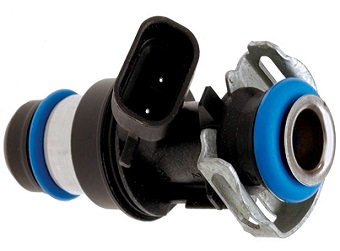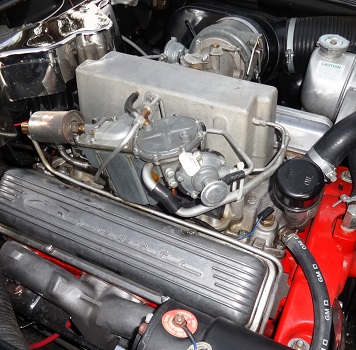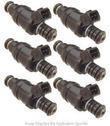
Electronic fuel injection or EFI was introduced to the automotive world in the 1950s. The Chrysler Corp. offered the electro-injector as an option on its Hemi V-8.
Shortly after its debut reliability problems forced Chrysler to recall the few systems that it did sell. Ironically, recalled vehicles were retrofitted with two four-barrel carburetors that had secondaries the size of dinner plates. Well that’s a slight exaggeration, but they were huge.
Chevrolet as an option on their flagship Corvette models designed and built one of the most famous early EFI systems. The Vettes that carried these factory installed fuel injection systems became affectionately called Fuelies.

Although worth a ton of money now, Chevy abandoned the system not due to reliability issues, but instead lack of sales stemming from a low level of consumer confidence in this brand-new system.
This beautiful example of an all original, numbers matching, fuel injected V8 makes its home inside the engine bay of a 1962 Chevrolet Corvette.
The Owner of the vehicle paid almost $90,000 dollars at a local car auction about 10 years ago. He thinks it’s probably worth double that figure today. It’s a two owner documented example with only 27,000 miles.
I think the general public wasn’t ready for changing the fuel delivery system from something that worked great already.
Nevertheless it was a tough pill to swallow for car makers back then. Three decades later the tide would turn when manufacturers abandoned the carburetor in favor of the electronic fuel injection system.
The return of the fuel injection system was necessary for the vehicle manufacturers to meet the ever-increasing corporate average fuel economy (C.A.F.E.) standards mandated by the government.
Modern Fuel Injection Systems

There are two basic types of EFI systems. These including throttle body injection or TBI and multiport fuel injection or MFI. In a TBI system, one or two shower head type injectors, depending on the engine size, are mounted above the throttle plates of a single or dual barrel throttle body.
Similar to a carburetor, atomized fuel is delivered above the throttle plates and distributed throughout the intake manifold. Although throttle body injection is more efficient than the carburetor it shares the inherent problem of uneven fuel distribution.
This is common to all the wet type intake manifold designs. With a multi-port type system fuel is delivered directly to each cylinder via individual injectors.
Now they call them direct injection. With the faster computer speeds on today’s cars these systems increase horsepower and reduce engine emissions at the same time. This is an amazing display of automotive technology.
You still need a plenum, throttle plates and intake manifold, but they are used exclusively for air induction. We call this a dry intake system. The injectors are mounted on the manifold so the injector nozzles are aimed at the backside of the intake valves. This arrangement provides a significant improvement in overall engine performance over the previous throttle body injection designs.
How Electronic Fuel Injectors Fire
Depending on the application the injectors in an electronic fuel injection system may be fired simultaneously, in groups or even one at a time.
The simplest configuration is to fire all of the injectors at the same time. With this method each injector is fired once every crankshaft revolution, which results in two shots of fuel per combustion cycle.
This method is used generally on single or dual throttle body injection systems. On multiport fuel injection this strategy is known as bank firing. This method separates the odd and even number cylinders into two separate groups.
The injectors in each group are fired simultaneously while the groups are fired separately. This system has since been replaced by the most popular method of firing multiport fuel injectors.
SFI stands for sequential fuel injection With this method, the injectors are fired one at a time when the time is right. Sfi injectors are fired in the same firing order as the spark plugs.
Unlike simultaneous and grouped injection, sequential fuel injection systems require a cylinder identification signal to initiate injector sequence or pulse to open the injector.
The most common way to produce this signal is with a camshaft position sensor or a synchronization slot cut into the crankshaft sensor magnetic ring. Most of the 1996 and up OBD two systems use this sequential fuel injection system. This is currently the most efficient way to supply your engine with fuel. Bookmark or share this fuel injection page with friends.
This next link takes you to my auto repair tips page. Learn more about your car on this page about Diy auto repair. Learn more about computer controlled automotive systems and check engine lights on this next page. Go from this page about electronic fuel injection to auto scan tools and diagnostic information. What is this automotive site all about? Who is the creator and why did he build it? Answers to these car questions and more on the homepage.
